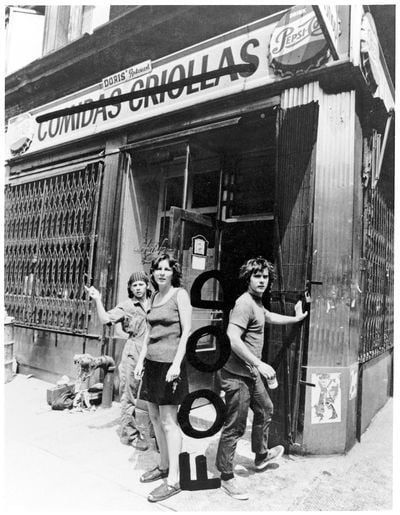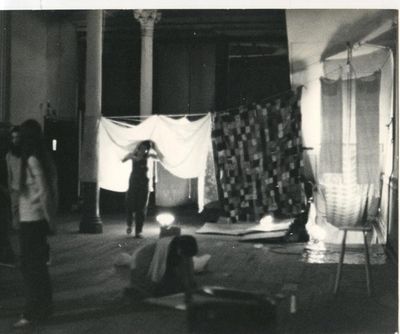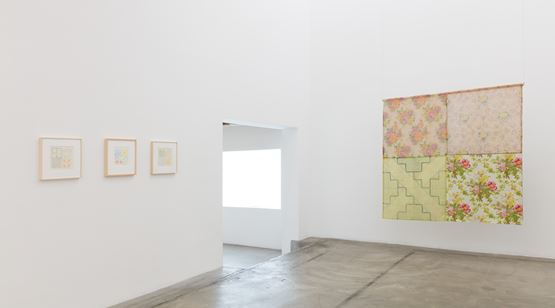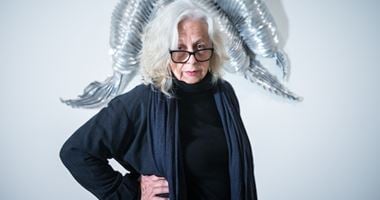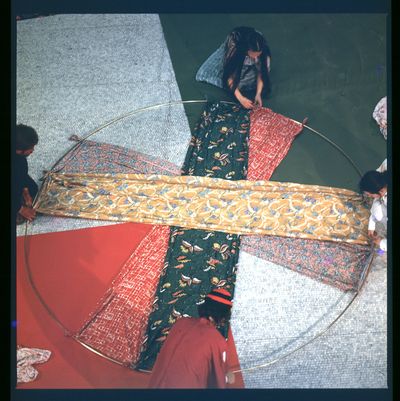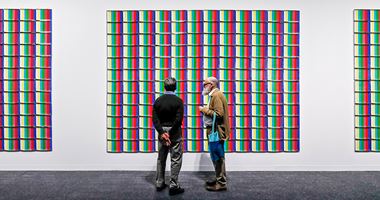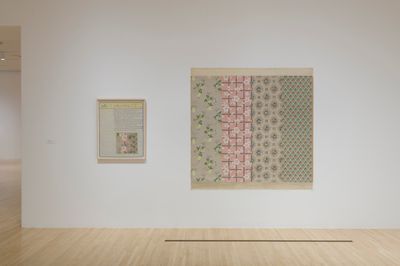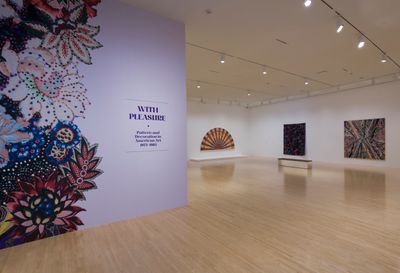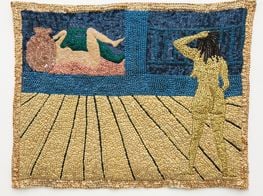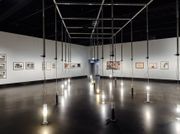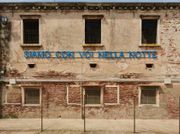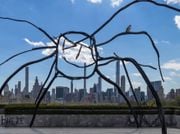Tina Girouard's Elevated Patterns

Tina Girouard, Air Space Stage (1972). Exhibition view: Tina Girouard, A Place That Has No Name: Early Works, Anat Ebgi, Los Angeles (22 February–13 June 2020). Courtesy Anat Ebgi.
Arriving in New York in 1969 from Louisiana, where she was born in 1946, Tina Girouard helped pave the way for SoHo's experimental scene of the 1970s, becoming a founding participant of, among other institutions, PS1 and Creative Time.
Girouard's multidisciplinary practice was defined by a resourcefulness and collaborative spirit that engaged with the boundaries of art-making in order to subvert them. This spirit, the artist explained in a 1973 interview with Avalanche magazine, originated from being in contact with jazz and blues musicians back home.
Girouard moved to New York after completing her BFA at the University of Louisiana Lafayette. She shared a Chinatown loft with fellow Louisianan Richard Landry, where the Philip Glass Ensemble would regularly rehearse, becoming a focal point for the downtown artist community.
In 1971, she co-founded the cooperative restaurant Food with Gordon Matta-Clark and Carol Goodden. What originated as a place to exchange ideas soon became a vital nexus for artists and communities in the area, providing employment, a site for performances, and, of course, nourishment, with meals offered by the likes of Donald Judd and Robert Rauschenberg, whose assistant, Hisachika Takahashi, served raw mackerel and wasabi sauce.
From Food, Anarchitecture was born—a movement helmed by Girouard, Matta-Clark, and Goodden, alongside Laurie Anderson, Suzanne Harris, Jene Highstein, Bernard Kirschenbaum, and Richard Landry. Less focused on architecture than it was on social space, artists worked with peripheral and disused sites to draw attention to the 'voids and failures that paradoxically glue together the built environment'; an approach exemplified by Matta-Clark's building cuts.[1]
Girouard's early performances similarly activated peripheral space in works such as Swept House (1969). Staged beneath the Brooklyn Bridge in an event curated by Clocktower Gallery founder Alanna Heiss, Girouard swept the architectural outlines of a house into the floor, incorporating garbage from the site into its plan, such as a discarded stove to symbolise a kitchen.
Located one block away from Food was 112 Greene Street Gallery (now White Columns), which artist Jeffrey Lew and dancer Rachel Wood opened in an old rag salvaging factory in 1970, offering another site of experimentation for artists such as Spalding Gray, Alice Aycock, Laurie Anderson, Chris Burden, and Richard Serra. Experiments varied: Charles Simmons covered all 4,000-square-feet of the basement floor with clay; Matta-Clark jack-hammered the entire concrete floor to expose a room-sized section of earth; on another occasion, Vito Acconci was enclosed in the space with a rooster, with Girouard assigned to capture the animal.
Girouard exhibited some of her earliest work at 112 Greene Street: performances and installations that articulated the architecture of the space, including Air Space Stage (1972)—four sheets of patterned fabric suspended from the ceiling to create a space within a space, their shades changing the light of the room depending on the time of day.
Air Space Stage was recently included among Girouard's early works in the late artist's solo exhibition A Place That Has No Name: Early Works, at Anat Ebgi in Los Angeles (22 February–13 June 2020). The piece is indicative of Girouard's use of patterned and ordinary materials, such as fabrics, wall paper, or linoleum, which she combined into basic rectangular or grid structures while asserting their eclectic surfaces—an accessibility of form that pointed to the artist's 'desire to communicate to a mass audience' using the language of repetition, which 'is common in industry and thus in life.' [2]
Girouard's use of textiles situated her as part of the Pattern and Decoration movement, founded by Valerie Jaudon and Joyce Kozloff...
Repetitive patterns also informed Girouard's performances, such as the strokes of the broom in the aforementioned Swept House, and in the later Pinwheel (1977), originally staged at the New Orleans Museum of Art as part of the 1977 exhibition Five From Louisiana, which included work by Lynda Benglis, Richard Landry, Robert Rauschenberg, and Keith Sonnier. Four performers, each representing personae charcterised as animal, vegetable, mineral, and other, enacted a ritualistic language devised by Girouard using objects and patterned silks. The performance was restaged in 2019 at Art Basel in Miami Beach by Anat Ebgi in collaboration with The Kitchen.
While associated with Post-Minimalism, Girouard's use of textiles also situated her in the Pattern and Decoration movement, founded by Valerie Jaudon and Joyce Kozloff, which made use of loaded, decorative surfaces to react against the restraint of male-dominated modernism.
Art critic Holland Cotter described Pattern and Decoration as 'the last genuine movement of the 20th century' in 2008.[3] He was responding to the exhibition Pattern and Decoration: An Ideal Vision in American Art, 1975–1985 at the Hudson River Museum—a legacy that is currently being revisited at the Hessel Museum of Art in the exhibition With Pleasure: Pattern and Decoration in American Art 1972–1985 (26 June 2020–28 November 2021), of which Girouard is part.
Curated by Anna Katz and Rebecca Lowery, With Pleasure represents the first full-scale scholarly survey of the Pattern and Decoration movement. The show travelled to Hessel Museum of Art from The Museum of Contemporary Art, Los Angeles, where it was staged between 27 October 2019 and 18 May 2020.
Girouard's work in the exhibition, Wall's Wallpaper III (1974), is composed of four rectilinear strips of Biedermeier wallpaper with differing patterns—a revision of the repeated, rectangular planes of minimalism that refuses the habitual function of wallpaper while maintaining its charmed floral surface. The effort connects Girouard's work to those of the approximately 50 exhibiting artists in With Pleasure, including Joyce Kozloff, Kim MacConnel, and Miriam Schapiro, whose practices leaned unapologetically into kitsch and gaudy designs in order to undermine perceptions of art forms coded as feminine, domestic, or ornamental.
Girouard's practice was equally pluralistic, and upon returning to Louisiana after a fire devastated her studio in 1978, her practice extended outwards. In 1980, she participated in the Venice Biennale, having shown in the Paris Biennale, Documenta VI, and Documenta V the decade before. Through the '80s, she helped found Artists' Alliance in Lafayette, and later spent time as director and president of the Festival International de Louisiane, where she became acquainted with the arts of Haiti. This encounter led to Port-au-Prince, where she kept a studio from 1990 to 1995.
Finding kinship with her birthplace of Louisiana, Girouard said that she lost her head and her heart in Haiti. She collaborated with Haitian artists such as Edgar Jean-Louis to create sequined and beaded voodoo flags, a selection of which were shown in an exhibition at New Orleans Museum of Art in 2019, co-curated by Nicolas Brierre Aziz of the Haitian Cultural Legacy Collection and NOMA's Katie A. Pfohl. She later authored the book Sequin Artists of Haiti, which honoured 12 flag-makers from Haiti, including Sylva Joseph and George Valris.
From playing a central part in New York's art scene, to wandering the 'Louisiana swamps and Voodoo societies in Haiti',[4] Girouard was an artist who evolved wherever she went. As she said in one 1982 interview, 'I believe one's life is made up of many parts, and that you get your world view or philosophy by adding up these parts.' [5]—[O]
—
[1] Odd Lots: Revisiting Gordon Matta-Clark's Fake Estates, Edited by Jeffrey Kastner, Sina Najafi, and Frances Richard, (Cabinet Books, New York), p. 63
[2] Pattern and Decoration: Ornament as Promise, Museum Moderner Kunst Stiftung Ludwig Wien (23 February–8 September 2019), exhibition booklet
[3] Harold Cotter, 'Scaling a Minimalist Wall With Bright, Shiny Colours', New York Times, 15 January 2008, https://www.nytimes.com/2008/01/15/arts/design/15patt.html
[4] Tina Girouard, Cue Art Foundation (9 December 2004–29 January 2005), exhibition catalogue
[5] Tina Girouard (1946–2020), Artforum, 24 April 2020, https://www.artforum.com/news/tina-girouard-1946-2020-82795

